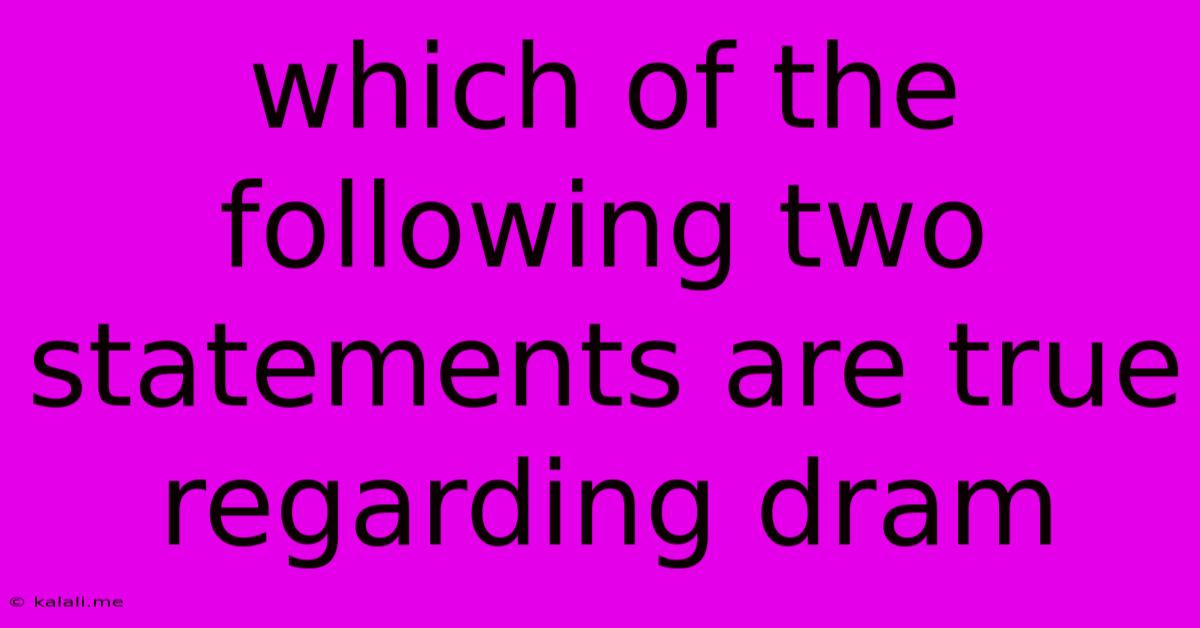Which Of The Following Two Statements Are True Regarding Dram
Kalali
Jun 15, 2025 · 3 min read

Table of Contents
Which of the Following Two Statements are True Regarding DRAM? A Deep Dive into Dynamic Random Access Memory
Dynamic Random Access Memory (DRAM) is a fundamental component of modern computing. Understanding its intricacies is crucial for anyone involved in software development, hardware design, or simply curious about how computers work. This article will explore two common statements regarding DRAM and determine their validity. We'll delve into the technology behind DRAM, its characteristics, and its limitations to provide a comprehensive understanding.
Meta Description: This article explores the truth behind two common statements regarding DRAM, clarifying its functionality, limitations, and importance in modern computing. Learn about the core characteristics of Dynamic Random Access Memory and improve your understanding of computer hardware.
Statement 1: DRAM requires constant refreshing to maintain data integrity.
This statement is true. Unlike static RAM (SRAM), which stores data in stable latches, DRAM stores data as electrical charges in tiny capacitors within memory cells. These charges gradually leak over time, leading to data loss if not regularly refreshed. This refreshing process involves periodically reading and rewriting the data stored in each cell, maintaining the electrical charge and preventing data corruption. The refresh rate is typically handled automatically by the memory controller, ensuring seamless operation for the user. The need for this constant refreshing is a key differentiator between DRAM and SRAM, impacting performance and power consumption.
Statement 2: DRAM is faster than SRAM.
This statement is false. In fact, the opposite is true: SRAM is significantly faster than DRAM. The fundamental difference in data storage contributes to this speed disparity. SRAM uses latches to store data, which are inherently faster and more energy-efficient than the capacitor-based storage of DRAM. Accessing data in SRAM involves simply reading the latch's state, while accessing data in DRAM requires both accessing and refreshing the charge in the capacitor. This additional step in the DRAM access cycle results in slower read and write times compared to SRAM. Therefore, while DRAM offers higher density and lower cost per bit, making it suitable for main memory, SRAM's speed makes it ideal for cache memory where fast access is paramount.
Key Differences between DRAM and SRAM:
Here's a table summarizing the key differences to further clarify the points discussed above:
| Feature | DRAM | SRAM |
|---|---|---|
| Data Storage | Capacitors | Flip-flops (latches) |
| Speed | Slower | Faster |
| Cost per Bit | Lower | Higher |
| Density | Higher | Lower |
| Power Consumption | Higher | Lower |
| Refresh Cycle | Required | Not Required |
| Typical Use | Main Memory (System RAM) | Cache Memory, Registers |
Conclusion:
Understanding the differences between DRAM and SRAM is crucial for comprehending computer architecture and performance. While both are types of RAM, their contrasting characteristics dictate their specific applications. DRAM, despite its slower speed, dominates the main memory market due to its higher density and lower cost. Meanwhile, SRAM's speed advantage makes it an essential component for fast-access memory like caches. By recognizing the validity of the statements analyzed here, and appreciating the trade-offs inherent in memory technology, we gain a deeper understanding of how computers function at their most fundamental level.
Latest Posts
Latest Posts
-
First 18 Elements Of Periodic Table
Jun 15, 2025
-
How Many Triangles Are There In This Figure
Jun 15, 2025
-
Aptitude Tests Are Used To Indicate
Jun 15, 2025
-
What Layer Do Meteors Burn Up In
Jun 15, 2025
-
Difference Between An Article And A Journal
Jun 15, 2025
Related Post
Thank you for visiting our website which covers about Which Of The Following Two Statements Are True Regarding Dram . We hope the information provided has been useful to you. Feel free to contact us if you have any questions or need further assistance. See you next time and don't miss to bookmark.